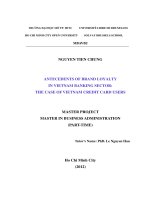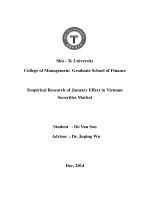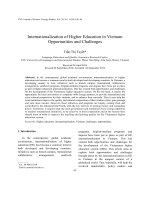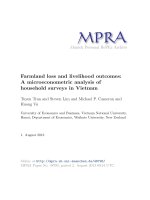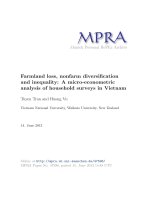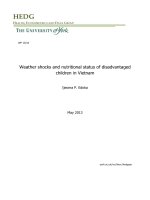Antecedents of consumer’s choice of fresh apples in vietnam
Bạn đang xem bản rút gọn của tài liệu. Xem và tải ngay bản đầy đủ của tài liệu tại đây (2.45 MB, 67 trang )
VIETNAM NATIONAL UNIVERSITY, HA NOI
VIETNAM JAPAN UNIVERSITY
---------o0o---------
NGUYEN THI THUONG
ANTECEDENTS OF CONSUMER’S CHOICE
OF FRESH APPLES IN VIETNAM
MASTER THESIS
BUSINESS ADMINISTRATION
VIETNAM NATIONAL UNIVERSITY, HANOI
VIETNAM JAPAN UNIVERSITY
---------o0o---------
NGUYEN THI THUONG
ANTECEDENTS OF CONSUMER’S CHOICE
OF FRESH APPLES IN VIETNAM
MAJOR: BUSINESS ADMINISTRATION
CODE: 8340101.01.
RESEARCH SUPERVISORS:
PROF. DR. KURATA HISASHI
DR. DO XUAN TRUONG
Hanoi, 2021
ABSTRACT
Nowadays the living standard in Vietnam has increased, consumers’ behaviors toward
food have shifted to high-quality food to protect their health. Since the Vietnamese
market provides imported fresh apples from different countries of origin, the
consumers have to face a matter to decide which types of country-originated apples
that they should choose for their own and family consumption. To be able to gain
competitive advantages in the market, it is very important for the marketers/ retailers
to understand the apple consumers well. Thus, this study investigated antecedents of
consumer’s choice of fresh apples to explore how the Vietnamese consumers choose
the origin of Envy apples between the USA and New Zealand which are the two
biggest exporters of apples in Vietnam. The reason for choosing Envy apples is
because this type of apple is very common and the most favorable by the buyers, they
can be imported from only the two aforementioned countries of origin. Besides
descriptive analysis, this study applied exploratory factor analysis (EFA) to reduce the
number of theoretical factors. Next, to test the hypotheses, a binary logistic model was
used to investigate what specific factors affect Vietnamese consumers’ choice of New
Zealand’s Envy apples compared to the U.S’s Envy apples. The result of the study
showed that the factors of Health consciousness and Food safety concern have
statistically significantly positive influence on the consumer’s choice of New
Zealand’s Envy apples; in contrast, the other factors including Promotion, Income and
Country of origin image have negative impacts on their choice. Therefore, when
consumers pay more attention to promotion, country image and their income, they
more likely choose the USA’s apples. The results can be used as recommendations for
the marketing managers/ retailers to understand more about the consumer behaviors in
the agricultural industry in order to have an effective marketing strategy and forecast
the apple demand to meet the consumers’ needs and wants. By applying the findings
into practices, that also helps improve the performance of the apple market in
Vietnam.
Keywords: Consumer’s behavior, consumer’s choice, food safety concern, price,
perceived quality, perceived value, health consciousness, promotion, country of origin
image.
ACKNOWLEDGEMENT
This research was conducted by a student of the MBA program at Vietnam Japan
University (VJU), a member of Vietnam National University.
First and foremost, I would like to have some words to express my journey as a
master’s student at Vietnam –Japan University for over 2 years. I graduated from
university some years ago. After graduation, I went into the workforce happily and
enjoyably. However, after a few years of work, I found that I needed to boost up my
knowledge and skills in business. Then, I tried to look for many different types of
MBA programs in Vietnam and overseas. I was lucky to have a friend who used to be
a third –intake student of VJU. She introduced me to the school. After getting great
support from VJU staff, I decided to join the MBA program.
Over the last 2 years, VJU has been my second home with great teachers, assistants,
and classmates. It is an unforgettable memory of my school life. Every time, when I
have struggled with any hard subject, I receive huge support from classmates and
lecturers. We stand side by side to achieve our goals.
My master thesis could have never completed without support from whom I would
like to sincerely thank to:
First of all, I am deeply thankful to my professor supervisors Prof. Dr. Kurata
Hishashi, Dr. Do Xuan Truong; advisors Prof. Yoshiki Matsui and Prof. Dr. Motonari
Tanabu for their expert guidance, understanding, and encouragement throughout my
study and research. All Professors have instructed me step by step giving me valuable
and meaningful advice and inspired critical ideas for my thesis.
I also want to express my sincere thanks to the IPO staff of Yokohama National
University who always helped me during four-month internship and the thesis journey.
Last but not least, I would like to especially thank Japan International Cooperation
Agency (JICA), Doctor Yoshifumi Hino, JICA expert cum and other VJU’s MBA
program teachers who devotedly provided insight and expertise that greatly advised
and assisted me during the master program. I cannot say more thanks to the MBA
program’s Assistants who gave me extremely efficient support to complete this
experience. I also thank my classmates of VJU’s MBA program for their invaluable
assistance in helping me during the data collection process and others.
TABLE OF CONTENT
ABSTRACT
ACKNOWLEDGEMENT
TABLE OF CONTENT
LIST OF TABLES
LIST OF FIGURES
LIST OF ABBREVIATITION
CHAPTER 1: INTRODUCTION
1.1. Background of the study
1.2. Purposes of study
1.3. Research questions
1.4. Scope of the study
1.5. Methodology of the study
1.6. Structure of the report
CHAPTER 2: LITERATURE REVIEW
2.1. Theoretical necessity
2.1.1. Concept of Consumer behavior
2.1.2. Consumer behavior model
2.1.3. Consumer buying decision-making process
2.2. Definition and previous studies
2.2.1 Food safety concern
2.2.2 Health consciousness
2.2.3 Price
2.2.5 Country of origin image
i
ii
iii
1
1
3
3
4
4
4
6
6
6
7
7
9
9
11
11
12
2.2.6 Promotion
2.2.7 Demographic factors
2.3 Conceptual framework and research hypotheses
CHAPTER 3: METHODOLOGY
3.1. Research method
3.2. Research process
3.3. Measurement scales
3.4. Sampling and Data collection
CHAPTER 4: DATA ANALYSIS AND FINDINGS
4.1. Sample Profile
4.2. Exploratory Factor Analysis
4.3. Descriptive Statistics and Reliability Test
4.4. Revised model after EFA
4.5 Binary Logistic Regression
CHAPTER 5: DISCUSSION AND RECOMMENDATIONS
5.1. Discussions
5.2. Implications
5.3. Limitations
5.4. Conclusions
REFERENCES
APPENDIX
Appendix 1
Appendix 2
13
14
15
17
17
17
18
19
22
22
23
26
28
29
34
34
36
39
39
40
45
45
49
LIST OF TABLES
Page
Table 3. 1: Measurement scales
18
Table 4. 1: Sample profile
23
Table 4. 2: The result of Rotated Component Matrix
25
Table 4. 3. The result of reliability test
26
Table 4. 4. The result of descriptive statistics
27
Table 4. 5. Estimated logit model for consumer’s choice of Envy apples
30
Table 4. 6 : The result of hypothesis testing
32
LIST OF FIGURES
Page
Figure 1.1: Vietnam’s apple consumption per capita from 2011 – 2017 (unit: kg)
2
Figure 2.1: Phillip kotler and keller (2015) model of consumer behavior
7
Figure 2.2: Kotler and keller (2012) - consumer buying decision-making process
7
Figure 2.3: The research framework (created by the author)
15
Figure 4. 1: Revised model after efa (created by the author)
28
Figure 4. 2: The model after analysis (created by the author)
32
2
LIST OF ABBREVIATITION
COO: Country of origin
COI: Country of origin image
CI: Country image
GDP: Gross Domestic Product
EFA: Exploratory factor analysis
3
4
CHAPTER 1: INTRODUCTION
1.1. Background of the study
Vietnam is an emerging market in the East Asia region, with a total population of 96.5
million, 68 percent of the population between the ages of 15-64 (The World Bank in
Vietnam, 2020). Vietnam has a low unemployment rate of about two percent. The annual
Gross Domestic Product (GDP) growth over the last five years is over six percent.
According to (The World Bank in Vietnam, 2021) Vietnam’s GDP reached $261 billion
with a growth rate of seven percent, GDP per capita is $ 2,740 in 2019. Due to Covid-19
crisis, the 2020 GDP grew by only 2.9 percent in decades, although it was considered as
one of the few best countries in the world. The nation’s economy is set to grow about 6.6
percent in 2021, to recover export-oriented manufacturing and robust the demand
nationwide. With rising income and living standards, Vietnamese consumers are
increasingly concerned with the quality of their food, and tend to choose pesticide-free and
high quality food. Fruits imported from foreign countries are commonly seen in Vietnam,
although they are not cheap.
According to a study conducted by the Vietnam Academy of Agriculture in 2017, an
average household living in the two biggest cities Hanoi and Ho Chi Minh City spends
about 8-9% of their monthly food expenditure on fruits. As (The USDA Foreign
Agricultural Service, 2020) reported that fresh fruits were imported in Vietnam
increasingly from 2016 to 2019 with the value of USD 1,371 and 2,493 million,
respectively. Among many types of fresh fruit imports, the imported fresh apples are one
of the most preferred fruits among Vietnamese citizens. The imported apples in Vietnam
have increased rapidly with a value of USD 66.54 million in 2017 compared to USD 51.61
million in 2016. The apple consumption per capita in Vietnam has risen over the years.
According to the (Food and Agriculture Organization of the United Nations, 2017), it
increased from 0.82 kg (2012) to 1.65 kg in 2017. The average apple import price was
counted up to $897 per ton in 2019. The nation has especially imported apples with
noticeably high prices ($1,608 per ton). The quantity of apples consumption is estimated
1
increasingly over the next few years due to Free Trade Agreements which Vietnamese
government has opened to many foreign businesses from all over the world and also the
consumer’s preference increases.
Figure 1.1: Vietnam’s apple consumption per capita from 2011 – 2017 (unit: kg)
Source “Food and Agriculture Organization of the United Nations (FAO)
According to (Export Genius, 2018) Vietnam is importing fresh apples from 18 foreign
countries including USA, New Zealand, China, France, Canada, Japan, Poland, South
Korea, Belgium, and Malaysia etc. The top three import sources of Vietnam supplied over
84% value of the apple fruit. Vietnam imports apple fruit from the United States and New
Zealand worth 42.01% and 24.57% share value in 2017.
Nowadays the living standard in Vietnam has increased, consumers’ behaviors toward
food have shifted to high-quality food to protect their health. Since the Vietnamese market
provides imported fresh apples from many different countries of origin, the consumers
have to face a matter to decide which types of country-originated apples that they should
choose for their own and family consumption. To be able to gain the competitive
advantages in the potential market of imported apples, it is very important for the
2
marketers/ retailers to understand the apple consumers well. By understanding the
important role of marketing in food consumptions, some researchers studied about
antecedents of consumer’s purchase behaviors of fresh apples (Astuti et al., 2015; Ceschi
et al., 2018, 2018; Gineikiene et al., 2016; Goossens et al., 2019; Ly & Trung, 2016).
Especially, some studies have revealed that origin is related to consumers’ food choice
(Götze & Brunner, 2019). However, consumers’ behaviors change in given contexts and
individuals’ characteristics. The purchases of consumers are influenced by various factors
including the buyers’ internal and external effects (Ramya & Ali, 2016). There are
inconsistencies among different categories of factors like socio-demographic, consumer
psychographics. Thus, this study aims to investigate antecedents of consumer’s choice of
fresh apples to explore how the Vietnamese consumers choose the origin of Envy apples
between the USA and New Zealand, which are the two biggest exporters of apples in
Vietnam. Envy apples are very common and the most favorable by the buyers, this apple
can be imported from only the two aforementioned countries of origin. This study outcome
is to provide insights into the ways marketers / retailers: (1) to forecast the demand of
country of origin – related fresh apples to meet the consumers’ needs and wants; (2) to
apply into marketing strategies; (3) and to help improve performance of the fresh apples
market in Vietnam.
1.2. Purposes of study
Based on the background study, the purpose of this research is to study the consumer’s
behaviors in context of choosing imported Envy apples between the U.S and New Zealand.
The result of the study is used as recommendations to support the marketers/retailers to
understand more about Vietnamese consumers in order to have a marketing strategy
effectively in the agricultural business.
1.3. Research questions
In this study, there are two research questions including:
(1) What specific factors affect Vietnamese consumers’ choice of New Zealand’s Envy
apples compared to the U.S’s Envy apples?
3
(2) What is the strongest determinant among categorical predictors that influences the
specific behavior of certain consumer groups in Vietnam?
The reason for choosing Envy apples is discussed in detail in part 1.4.
1.4. Scope of the study
This study is targeted as research regarding consumer behaviors of marketing perspective
to investigate the antecedents of consumers’ choice of fresh apples in Vietnam. The
Vietnamese market provides many distinct types of apples in terms of brands and countries
of origin. According to (ASIAFRUIT, 2019), apples are one of the five key categories –
apples, grapes, kiwifruit, pears and oranges – which represent 96 per cent of the total
imported fruit section in Vietnam. From the research of (T&G Global and Opp, 2019), it
indicated that shoppers have a high purchase intention and are willing to pay more for
Envy apples than other types of apples. Furthermore, Vinmart is one of the biggest
convenience chains in Vietnam and also the most preferred by Vietnamese consumers.
Especially, in Vietnam, the Envy apples are imported from the USA and New Zealand.
Therefore, this study, Envy apples imported from the two aforementioned countries are
conducted as alternative choice.
Hanoi and Ho- Chi- Minh were chosen to target the participants of the survey. These are
the biggest cities in Vietnam with high living standards. The respondent ages range from
18 to 45 years old because they are responsible for shopping food for their families.
1.5. Methodology of the study
In the scope of this study, the participants are domestic consumers. To achieve the research
objectives, the study used quantitative research method. Data was collected by online
survey, then analyzed by descriptive statistics, factor analysis, and binary logistic
regression model.
1.6. Structure of the report
This report includes five main chapters:
4
-
Chapter 1 introduces information consisting of the background of the study, the
research objectives, the scope, the methodology and the structure of the report in general.
-
Chapter 2 provides the theoretical background and summarizes the prior researches
of consumer behaviors in food markets. It also explains the hypotheses and theoretical
model of the study.
-
Chapter 3 explains methodology, the research design, as well as the data collection’s
process in detail.
-
Chapter 4 indicates the results of data analysis. This part takes account of
descriptive analysis, factor analysis, especially the binary logistic regression model is
exploited to test the hypotheses to find out the antecedents of Vietnamese consumer’s
choice of fresh apples imported for the USA and New Zealand.
-
Chapter 5 comprises of the conclusions of the findings, recommendations for the
retailers to apply into practices of agricultural business, and some limitations that the
future research can develop for further studies.
-
References part contains all the acknowledged studies and resources.
-
The part of the appendix shows the list of questionnaires in both Vietnamese and
English versions. The Vietnamese copy was delivered to the respondents to collect the
data.
5
CHAPTER 2: LITERATURE REVIEW
This chapter provides a theoretical necessity mainly focused on consumers’ purchasing
behaviors. The part also reviews and analyses the relationships between predictive factors
including food safety concern, health consciousness, price, perceived quality, country – of
– origin image, and promotion with consumer’s purchase behaviors. The chapter includes
three sections:
-
The first section discusses the concept, model and buying – decision making
process of the consumers.
-
The second section explains the definition of key predictors and how they affect
consumers in terms of food consumption.
-
Finally, the last section shows the conceptual model and hypotheses.
2.1. Theoretical necessity
2.1.1. Concept of Consumer behavior
Consumer behavior is that consumers demonstrate in finding, purchasing, using, and
evaluating products and services that they expect to satisfy their individual needs (Bettman
et al., 1998). According to (Hantula & Wells, 2014), the choice behaviour is considered as
a part of consumer behaviours.
In marketing perspectives, the researchers would like to study on consumer behavior with
the aim of identifying individual characteristics, needs, preferences, shopping habits,
specific identification of the type of their consumer. The marketers should be able to know
these consumer’s questions including “what to buy, why to buy, how to buy, where to buy,
6
when to buy, how much to buy” to build a suitable marketing strategy, to motivate
consumers to buy products and services.
2.1.2. Consumer behavior model
When consumers purchase food, they are influenced by many factors including extrinsic
and intrinsic features of products. While some aspects of products, the consumers can get
related to physical and functional features of a particular product, for example, taste,
appearance, amora. Many other features that are not physical parts can be understood as
extrinsic attributes such as price, label, and origin. In many studies, the researchers found
that consumers use both extrinsic and intrinsic attributes to decide whether they buy the
products or services. Especially, in food industry, when the buyers can not taste the food,
they have to use other external cues to their purchase.
Figure 2.1: Phillip Kotler and Keller (2015) Model of Consumer Behavior
Kotler and Keller (2015) systematized the factors that lead to consumer purchasing
decisions. The consumer behavior model shows that marketing factors include product,
price, distribution, promotion and other factors such as economics, politics, technology,
culture impact the buyers’ purchasing decision of product choice, brand choice, dealer
choice and others. However, by reviewing previous studies, the author understood that the
consumer purchase behaviour could be explored by separate or combined factors in given
contexts or situations.
7
2.1.3. Consumer buying decision-making process
To lead to the act of buying, consumers go through five stages, according to (Kotler &
Keller, 2015).
Figure 3.2: Kotler and Keller (2012) - Consumer buying decision-making process
Stage 1: Need recognition
The consumer’s buying decision-making process starts when the consumers feel the
difference between the actual situation and the desired state, then they form the demand.
The cause of this demand formation is that consumers are subjected to stimuli from within
or from outside. Therefore the enterprises must pay attention to find out: the circumstances
in which the demand arises, what are the needs, what makes the demand appear, the
demand is directed to which goods / services to satisfy. On the other hand, businesses also
need to find suitable marketing stimuli that can elicit demand, promote demand to become
motivation (desire) of potential consumers.
Stage 2: Search for information
As soon as the demand appeared, the consumer was to find out more information to satisfy
the demand. The purpose of seeking more information is to better understand products /
brands, supply activities of businesses in relation to customers’ choices and reduce risks in
shopping and consumption. The level of information seeking is different for each
individual’s needs that pay more attention to information related to the need, or to consult
that products/ services. The searchers also find the information by many different ways and
sources.
Information sources: Depending on the nature of goods and services, customers can choose
one or several sources of information before making a decision to buy or not to buy for
8
example other individuals’ references (friends, neighbors, colleagues, acquaintance…);
commercial information (advertising, through vendors, exhibitions); general information
(mass media, research organizations ...).
Stage 3: Evaluation of options
After searching for enough information about the products / services of what they need;
the consumers form a set of choice, each with typical characteristics are different. They
evaluate options to choose the one that consumers think are the most optimal and most
suitable for them.
Stage 4: Purchase decision
After evaluating the options, the consumers form a buying intention. However, from the
buying intention to actual purchase, the buyers are often influenced by a number of other
effects that can change their mind.
Stage 5: Post-purchase evaluation
Post-buying behavior is the collection of consumers’ emotions, attitudes and actions when
they consume the products/ services. Post-purchase rating is directly related to the level of
customer satisfaction after using the company’s products / services. After purchasing and
using the products/ services, they will either be satisfied or dissatisfied with the product
depending on the degree of difference between the consumer’s expectations before buying
the product versus the actual quality of the product.
2.2. Definition and previous studies
The part reviews and analyses the relationships between predictive factors including food
safety concern, health consciousness, price, perceived quality, country of origin image, and
promotion with consumer’s purchase behaviors.
9
2.2.1 Food safety concern
The food safety concern can be understood as the ways by which consumers worries about
pesticide residues in food and also about other concerns of food-related diseases.
(Michaelidou & Hassan, 2008) mentioned that the consumers think of food safety with
regard to chemical sprays, fertilizers, hormones and artificial additives.
Because food safety is very important for everyone in order to make sure they have good
health while consuming any food. In many countries, the Government plays an important
roles in making strict policies on food field, that guides the consumers have knowledge of
knowing about food problem. Especially, in developed countries such as the USA, Europe
the consumers’ preference on locally grown fruits is greater than imported ones
(Gineikiene et al., 2016; Schneider & Francis, 2005). However, nowadays, in many
developing countries, since the living standard has increased, consumers pay more
attention into the food safety . The studies of (Liguori et al., 2018; Mohan Kathuria &
Singh, 2016; Neill & Holcomb, 2019; Pham et al., 2019; Terano et al., 2016; Yang et al.,
2021, 2021) showed that food safety concern has positive impact on consumer’s purchase
behaviours in food industry. In Vietnam, the consumers’ demand of great quality and safe
food has increased recently because of the increasing living standard, the consumers also
have high worries about food safety. The study of (Ha et al., 2019) shows that people had a
high level of concern towards food safety; especially fresh fruits, vegetables, and meat
were evaluated to be the most unsafe. The study of (Cadilhon et al., 2006) already
mentioned about the development problem of the supply chain system of vegetable
markets in Ho Chi Minh City in particular, Vietnam in general. The competition between
supermarket outlets and traditional traders for wholesale and retail has increased.
Furthermore, the stakeholders involved have little knowledge of consumers’ purchase
behaviors regarding product safety.
(Ortega & Tschirley, 2017) concluded in their paper that the currently existing literature
related to food safety in developing countries is still inconsistent with a prominent issue to
be solved. With the rapid growth of urbanization, income, educational levels, and changes
of many other socioeconomic aspects; the issues of food safety have become increasingly
10
important to consumers. They also suggested that the additional researches on consumer
behavior for food safety are still in need to explore and to better understand consumer
purchase behaviors. Therefore, food safety concern is necessary in this study, the
hypothesis is stated as below:
Hypothesis (H1): Food safety concern affects Vietnamese consumer’s choice of fresh
apples between the U.S and New Zealand.
2.2.2 Health consciousness
Health is defined as a state of physical comfort, not simply a lack of disease. Concern is
related to the human psychological system . Consumers who care about their health are
those who know well their own health status and are concerned about their health benefits
or issues when they choose daily food for example meat, fruits and vegetables (Hsu et al.,
2016; Michaelidou & Hassan, 2008; Pham et al., 2019; Tran et al., 2020). They are willing
to do things to maintain good health, improve health and quality of life. In these days, the
standard of living is improved, the health issue is also paid more attention by the
populations. There are many factors affecting human health such as internal and external
factors such as air, food, ... For that reason, people have great worries of choosing
vegetables and fruits. Thus, the second hypothesis is stated as follows:
Hypothesis (H2): Health consciousness affects Vietnamese consumer’s choice of fresh
apples between the U.S and New Zealand.
2.2.3 Price
Price is considered as an important predictor in consumers’ fresh food choices. Price is the
value of goods. The price is set according to the product cost, price of a competitor or the
marketing strategies. For consumers, the price of a product is the amount that they have to
pay in order to own and use the products. When deciding to buy any products or services,
consumers often put prices into consideration carefully. They see price as an indicator of
quality. In terms of imported fresh fruits in the Vietnam market, the higher price is, the
better quality the products offer. The studies of (Abdullahi et al., 2017; Bukhari et al.,
2020; Hieu, 2020; Hoa et al., 2018; Ly & Trung, 2016, 2016; Mohan Kathuria & Singh,
11
2016) also found that price has a positive influence on consumer purchase behaviors of
apples, especially imported apples from developed countries. This means that the higher
price of apples is, the more demand increases.
Nonetheless, the consumers also consider the price factor in terms of perceived value.
According to (Zeithaml, 1988) “Perceived value is a consumer’s overall assessment of the
utility of a product or service based on their perceptions of what is received and what has
to be spent”. Furthermore, the author argued that some consumers perceive value when
there is a low price, others perceive value when there is a balance between quality and
price. Thus, for different consumers, the perceived value of the products may be different.
The current study, therefore, developed the hypothesis as below:
Hypothesis (H3): Price affects Vietnamese consumer’s choice of fresh apples between the
U.S and New Zealand.
2.2.4 Perceived quality
Perceived quality is the consumer’s perception of the overall quality of a product or
service to their expected requirement when comparing other products of the same type
(Aaker, 1991). In this context, perceived quality is a subjective and very relative concept,
its value and scope may vary depending on the subject and the type of product (Nguyen
Thanh Long, 2002). Perceived quality has three components: (1) internal factors associated
with physical structures, the nature of the product and the process of consumption - the
source of usefulness; (2) external factors; creating added value, not tied to physical
structure; (3) hermaphroditic (internal and external) (Olson & Jacoby, 197; Olson, 1977).
The consumers often cannot fully and accurately assess product quality. Therefore, the
quality that they perceive is the factor that customers use as a basis for making
consumption decisions. Consumer perceptions vary from product to product and due to
their subjective perception. According to Ajzen’s intended behavioral theory (1975),
behavior is the result of perception. Consumers think about product quality and how their
attitude towards the product will lead to their consumption decision or not. Therefore, the
perceived quality of consumers is the basis for deciding whether to consume or not.
12
Hypothesis (H4): Perceived quality affects Vietnamese consumer’s choice of fresh apples
between the U.S and New Zealand.
2.2.5 Country of origin image
Country of origin (COO) has been widely explained by many researchers. (Cordell, 1992)
described COO as the effect of the group of external factors to build reputation and
assurance for customers. External effects include abstract elements of the product such as
price, branding, and maintenance and maintenance policies, in contrast to the internal
factors that express the product attributes such as taste, appearance, texture, or color.
(Watson & Wright, 2000) mentioned that the country of origin effects are positive or
negative effects on consumer’s perceptions, purchasing decisions, or post-purchase
behavior of the product. Country of origin image (COI), or Country Image (CI) studies
help emphasize the consumer’s subconscious image of a product’s country of origin. This
allows the researchers to delve into the problem and answer the question of what reasons
consumers make COO-based consumption choices.
(Martin & Eroglu, 1993) defined country image as “the total of all descriptive, inferential,
and informational beliefs one has about a particular country” .Country image is commonly
used in tourism research. The tourist bases on this predictor to decide whether to buy
products/ services of a country before coming to the destination.
Recently, it is used in goods marketing perspectives. (Bruwer & Buller, 2012; Kumara &
Canhua, 2010) found that the COO-image is one of the most significant phenomena that
impact the evaluations of the foreign products, and on consumer’s purchasing behaviors.
The studies of Amna Shahazad, 2015; Kabadayi and Lerman, 2011; and Ahmed and
D’Astous, 2008) found that the COO-image did not only attract consumers, but also
influence on
their product choices. Country image is widely researched in tourism
marketing, but it seems still not common in foreign food/goods. Especially in Vietnam, a
study of (Long, 2014) used CETSCALE to determine the impact of this factor on the
product judgment and the willingness to buy foreign products of domestic consumers
including three products: toddler milk powder, pharmaceuticals, and fruits. Country of
13
origin image was recommended as a new approach to exploring the Vietnamese consumers
towards imported products, in particular fruits, milk and medications. Therefore, this study
intends to explore about country of origin image as one of the independent factors.
Hypothesis (H5): Country- of- origin image affects Vietnamese consumer’s choice of fresh
apples between the U.S and New Zealand.
2.2.6 Promotion
Marketing is the business’s efforts to inform, persuade, remind and encourage its
consumers to buy products and become its loyal customers. A marketing mix consists of
some different activities: Advertising, Public Relations, Sales Promotion, Personal Selling
and Direct Marketing. Nowadays, due to high competition in the market, marketing has
obviously promoted its effects. By conducting marketing strategy, businesses inform their
target customers about the presence of products on the market, encourage customers to buy
products, promote the consumers’ buying decision faster. When the marketing activities
are conducted more frequently, the consumers get more opportunities to know and pay
attention to the product; and the ability to buy can be achievable. Especially with fruits and
vegetables, consumers still have the shopping habit of both traditional and online channels,
it is very necessary to contact and create conditions for customers to experiment with
various shopping channels. Marketing or promotion have been studied in many studies,
and the findings has mentioned that promotion has a positive influence on consumers
purchase behaviors (Bukhari et al., 2020; Hieu, 2020; Hoa et al., 2018; Mohan Kathuria &
Singh, 2016) Therefore, hypothesis H4 is stated as follows:
Hypothesis (H6): Promotion affects Vietnamese consumer’s choice of fresh apples
between the U.S and New Zealand.
2.2.7 Demographic factors
Consumer perceptions are different across the different levels of demographics such as
education level, age group, income level and gender etc. Previous research found that
14
